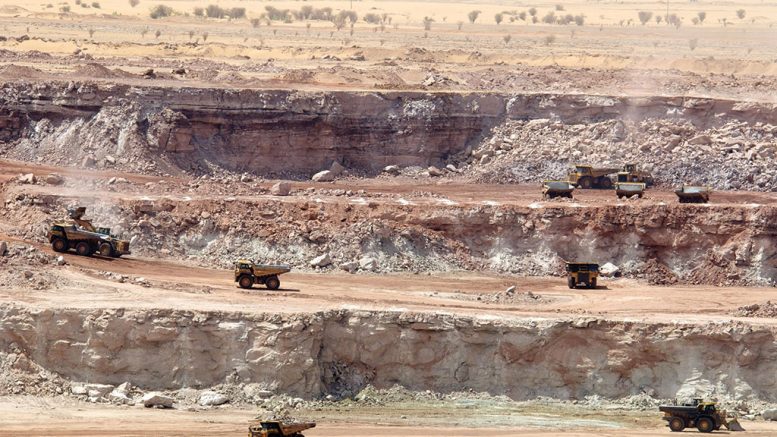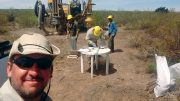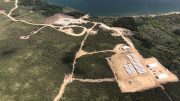While uranium oxide prices continue to drift in the doldrums, several uranium companies have still raised a bit of money to explore and carry out modest programs. Here is a look at eight uranium-focused companies that are active in 2019.
ALX URANIUM
Based in Vancouver and led by CEO and chairman Warren Stanyer, ALX Uranium (TSXV: AL; US-OTC: ALXEF) is the product of the merger between Alpha Exploration and Lakeland Resources.
ALX is focused on exploring for uranium and other minerals in Saskatchewan’s Athabasca basin.
In late May, ALX closed a $1.5-million private placement, with funds of the flow-through portion of the financing directed to exploring its uranium assets in Saskatchewan, which cover 2,000 square kilometres.
Earlier in May, ALX staked 271 sq. km of claims prospective for nickel, copper and cobalt mineralization at its wholly owned Flying Vee project located outside the Athabasca basin near Stony Rapids, Saskatchewan.
ALX says it first staked five claims at Flying Vee in 2018 covering the historical Reeve Lake nickel showing, and acquired another eight claims in April 2019 when a staking rush was triggered in the area by emerging battery metals company Kobold Metals.
ALX Uranium’s Hook-Carter uranium project in the Athabasca basin’s Patterson Lake corridor is more advanced — a 2019 drilling program began in January. Exploration at Hook-Carter is operated by 80%-owner Denison Mines (TSX: DML, NYSE-AM: DNN), with ALX holding the other interest.
APPIA ENERGY
Toronto-based Appia Energy (CSE: API; US-OTC: APAAF) is involved in uranium and rare earth elements (REE) exploration in the prolific Athabasca basin district of northern Saskatchewan, and uranium and REE development and mining in northern Ontario’s historic Elliot Lake mining camp.
Appia is led by president and CEO Anastasios (Tom) Drivas, who is described as a business entrepreneur with over 30 years of experience in various industries, including more than 20 years in the mineral resource industry. He is also president and CEO of Romios Gold Resources, a publicly traded company founded in 1995.
Geologist James Sykes is Appia’s vice-president of exploration and development, and has done previous work in the Athabasca basin related to NexGen’s Arrow deposit and Hathor’s Roughrider deposits.
Appia’s uranium properties in the Athabasca include Loranger, Eastside and North Wollaston — all in the Wollaston Lake area.
At North Wollaston, the company is planning an airborne radiometric, magnetic and electromagnetic geophysical survey over the property, which hosts four uranium-bearing surface showings with grades up to 0.495% U3O8.
Appia’s REE project in the Athabasca is named Alces Lake and is located east of Uranium City. The company describes Alces Lake as the highest-grade REE occurrence known in Saskatchewan, with grades comparable to those found in South Africa’s world-class Steenkampskraal deposit.
In 2018, Appia completed the first-ever drill campaign on the property, with 15 holes confirming depth extension of high-grade surface REE mineralization.
Appia is returning to Alces Lake in June 2019 with a work program that will include 3,000 metres of drilling.
AZINCOURT ENERGY
Vancouver-based, Alex Klenman-led Azincourt Energy (TSXV: AAZ; US-OTC: AZURF) has just raised $1.6 million in a private placement, with proceeds earmarked for general working capital purposes and to advance the company’s East Preston uranium project in Saskatchewan’s Athabasca basin, where it is partnered with Skyharbour Resources (TSXV: SYH) and Clean Commodities (TSXV: CLE).
Azincourt is earning a 70% interest the Eastern part of the Preston project, which is one of the largest tenured land positions in the uranium-rich Paterson Lake region, and near NexGen Energy’s high-grade Arrow deposit, Fission Uranium’s Triple R deposit and AREVA–Cameco–Purepoint’s joint venture (Spitfire).
Azincourt says Orano Canada (formerly Areva Resources Canada) optioned 49.6 sq. km of the Preston project for up to $7.3 million in exploration expenses, and over $2.5 million in exploration expenses have been spent on the East Preston project over the past three years.
Azincourt’s other major asset its Escalera Group uranium-lithium project located on southeastern Peru’s Picotani Plateau.
DENISON MINES
A member of the Lundin Group of Companies and led by David Cates, Denison Mines (TSX: DML; NYSE-AM: DNN) is a Toronto-based senior developer focused on exploration and development of uranium assets in Saskatchewan’s Athabasca basin.
Denison says its 90%-owned Wheeler River “ranks as the largest, undeveloped, high-grade uranium project in the infrastructure-rich eastern portion of the Athabasca basin.”

The camp at Denison Mines’ Wheeler River uranium project in northern Saskatchewan. Credit: Denison Mines.
Denison reported in June that the Canadian Nuclear Safety Commission and the Saskatchewan Ministry of Environment have accepted the provincial technical proposal and federal project description submitted by Denison for the in-situ recovery uranium mine and processing plant proposed for Wheeler River.
Denison also said it has “executed a series of memoranda of understanding with Indigenous communities in support of the advancement of the project.”
The firm’s exploration portfolio in the basin consists of numerous projects covering 3,200 sq. km, and its other assets include: a 22.5% ownership interest in the McClean Lake joint venture, which includes several uranium deposits, and the McClean Lake uranium mill, which processes ore from the Cigar Lake mine under a toll-milling agreement; a 25.17% interest in the Midwest and Midwest A deposits; and a 65.45% interest in the J Zone deposit and Huskie discovery on the Waterbury Lake property.
Denison is also engaged in mine decommissioning and environmental services through its Denison Environmental Services division and manages Uranium Participation Corp. — a publicly traded company that invests in uranium oxide and uranium hexafluoride.
GLOBAL ATOMIC
Toronto-based junior Global Atomic (TSX: GLO; US-OTC: SYIFF) is advancing the high-grade, large DASA uranium deposit in Niger.
In an unusual feature for a uranium developer, Global Atomic says it “benefits from the significant dividend stream generated by its share in the Befesa Silvermet zinc concentrate production facility in Turkey.”
In a May 30 update, Global Atomic reported that an updated resource statement for DASA is nearly completed, and will include all assay data from its 2018 drill program. A mine plan based on the resource update will then be developed and included in a feasibility study due in the first half of 2020.
The company says it will apply for the DASA mining permit in mid-2020, with permits expected by the fourth quarter of 2020.
It adds that “work on the resource update and feasibility study indicate the DASA deposit is a large, high-grade uranium deposit that will demonstrate strong economics,” and that discussions with French uranium producer Orano Mining regarding the memorandum of understanding in July 2017 are “progressing well,” and the company is “considering various options” for early ore delivery.
ORANO
Paris-based Orano is a French government majority-owned nuclear fuel cycle company that emerged in 2017 out of the ailing nuclear conglomerate Areva, which slipped into insolvency in the mid-2010s, and required massive restructuring.
Areva sold or discontinued its renewable energy businesses, sold its reactors business subsidiary (now named Framatome) to EDF, and its nuclear propulsion and research reactors subsidiary (now named Technicatome) to Agence des participations de l’État. Its nuclear cycle business was placed in a separate company New Areva, which was later renamed Orano.
Orano has 16,000 employees worldwide and is described as engaged in uranium mining, conversion-enrichment, spent fuel recycling, nuclear logistics, dismantling and nuclear cycle engineering activities.
Orano Canada (previously named AREVA Resources Canada) is headquartered in Saskatoon, Sask., and carries on the work done by its predecessors for more than 50 years. Its most notable asset is its McClean Lake uranium mill, which Orano describes as “the most technologically advanced mill in the world for the processing of high-grade uranium ore, without dilution.”
At the time of the name change in February 2018, Orano Canada president and CEO Vincent Martin said that “although we now have a new brand, we remain the same company here in Saskatchewan, focused on uranium exploration, mining and milling, with the same commitment to safety, environmental protection and our communities.”
PLATEAU ENERGY METALS
Toronto-based junior Plateau Energy Metals (TSXV: PLU) changed its name from Plateau Uranium in March 2018, after having changed its name from Macusani Yellowcake in 2015.
As its new name suggests, Plateau Energy Metals is putting more focus on its lithium assets in Peru than on developing its large, long-held, low-grade Macusani uranium deposit in the Macusani plateau area of southern Peru.
Plateau completed a preliminary economic assessment of Macusani in 2016 that showed a robust project at US$50 per lb. uranium oxide (U3O8). At press time, spot prices were US$25 per pound.
Total resources from five deposits at Macusani stand at 95.2 million measured and indicated tonnes at 0.0248% U3O8 for 51.9 million lb. U3O8, plus 130 million inferred tonnes at 0.0251% U3O8 for 72.1 million lb. U3O8. There is an economic amount of lithium by-product in four of the uranium deposits.
Plateau broadly proposes to build a mine that produces 6 million lb. U3O8 per year for 10 years at a US$300-million initial capital cost, and relatively low cash-production costs of US$17 per lb. U3O8.
At a US$40 per lb. U3O8 price, Plateau says Macusani has a post-tax net present value of US$360 million and a 29.2% internal rate of return, with a 2.5-year payback.
Plateau says its key Falchani lithium project the Puno District in southeastern Peru is a “potentially scalable, open-pittable hard rock lithium deposit,” where metallurgical work to date “demonstrates the potential to produce a high purity lithium carbonate product.”
The current resource estimate shows indicated resources of 60.92 million tonnes at 2,954 parts per million (ppm) lithium (0.64% Li2O equivalent) containing 0.96Mt lithium carbonate equivalent (LCE) and inferred resources of 260.1 million tonnes at 2,706 ppm lithium (0.58 Li2O equivalent) containing 3.75Mt LCE.
ZADAR VENTURES
Vancouver-based Zadar Ventures (TSXV: ZAD; US-OTC: ZADDF) is another junior with a “green energy” asset mix of lithium and uranium.
In March, Zadar directors decided to consolidate shares on a 10-to-1 basis, leaving the company in early June with 17.7 million shares outstanding for a $1.8-million market capitalization, with shares trading at 10.5¢ per share.
The company is undertaking exploration for lithium projects in Nevada, known as the WSP and CR claims. Its uranium exploration projects are in Saskatchewan’s Athabasca basin and include Passfield Lake, West Carswell, Riverlake and Upper Poulton Lake.
Zadar has an option to acquire a 100% interest in the Passfield Lake, which is situated on the Passfield structure (which Zadar says is possibly an astrobleme, and similar to the Cluff Lake structure) and astride the Cable Bay shear zone (CBSZ).
Zadar adds that exploration has “identified important indications of the presence of uranium-bearing hydrothermal fluids along the fault that forms the eastern arm of the CBSZ. Further drilling is required to adequately test for uranium mineralization in this structurally complex area, especially where shallow basement (300 to 500 metres) is indicated by geophysical surveys.”




Be the first to comment on "Mining Energy Snapshot: Eight juniors active in world’s uranium hotspots"